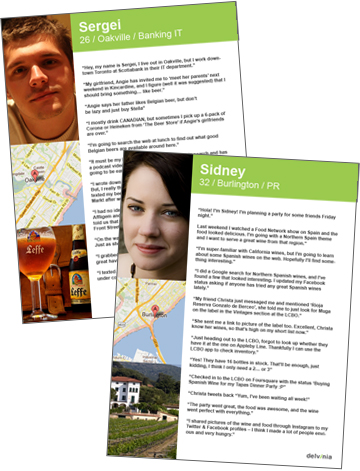“Our most effective (design) tool is profoundly simple: Develop a precise description of our user and what he wishes to accomplish.” – Alan Cooper on goal-directed design, The Inmates Are Running the Asylum
 Personas are an extremely valuable tool for marketers and designers in any field, as they bring market segments and individual customers to life and they evoke empathy for the customer. In this way, they are critical to the customer-centric design process here at Delvinia, and our customer insight team often develops and uses personas when we’re creating a new digital experience for a client.
Personas are an extremely valuable tool for marketers and designers in any field, as they bring market segments and individual customers to life and they evoke empathy for the customer. In this way, they are critical to the customer-centric design process here at Delvinia, and our customer insight team often develops and uses personas when we’re creating a new digital experience for a client.
If you’re not familiar with the concept, a persona is a single user archetype representative of a group of people with similar goals, attitudes and behaviours. A single persona typically includes an image, an individual narrative, a distillation of the user’s primary motivation, key behaviours, goals and needs. It puts the brand directly in the shoes of the customer.
Why do we use personas?
We use personas:
- To stop us from making assumptions and generalizations about customers (remember, we’re not designing for ourselves)
- Because they evoke empathy for real people with real needs and goals
- To ensure that business and design decisions satisfy the user’s goals
We know we have achieved success when:
- The team can focus the strategy and design on a small group of critical user archetypes.
- The knowledge we generate about those users is actionable.
- The personas are broadly communicated and used consistently throughout the design process.
- They have staying power. That is the personas can be replicated and validated year-to-year.
We create personas can be created through a variety of qualitative and quantitative methods, but we strongly recommend that qualitative inquiry be part of the process whenever possible. Let’s face it, quantitative research can produce significant insights, but one simply cannot empathize with a statistic, nor even a cluster of statistics eloquently described as a segment. Empathy happens between individual people.
Well made personas should also be well used. They not only influence our strategy, which provides the framework for business decisions, they also influence marketing, and design. Everything from developing new lines of business, to executing a brand campaign, to determining information architecture can benefit from the application of personas, which remind us to view the product through the customer’s eyes.
It has also been our experience that creative, unconventional approaches to persona design can likewise stimulate creative, innovative thinking about product development. Though all personas should generally include the same basic elements, the format of presentation can vary. Depending on your product and your customer, for example, you might consider mocking up a Facebook page or imagining a yearbook excerpt as a way to meaningfully represent the information. It’s all about getting closer to that end user.